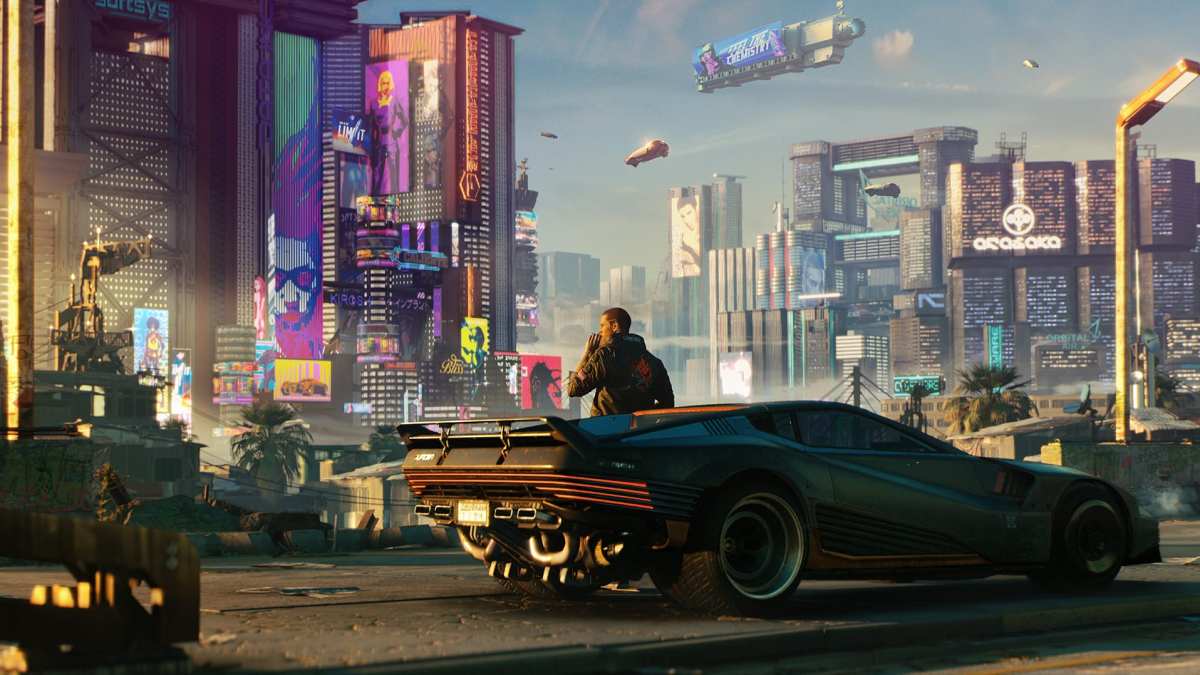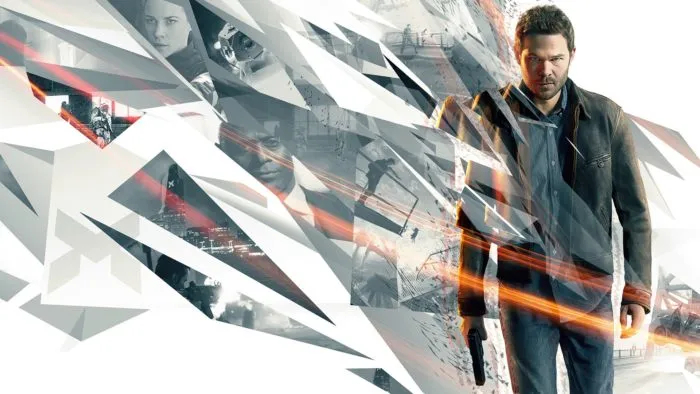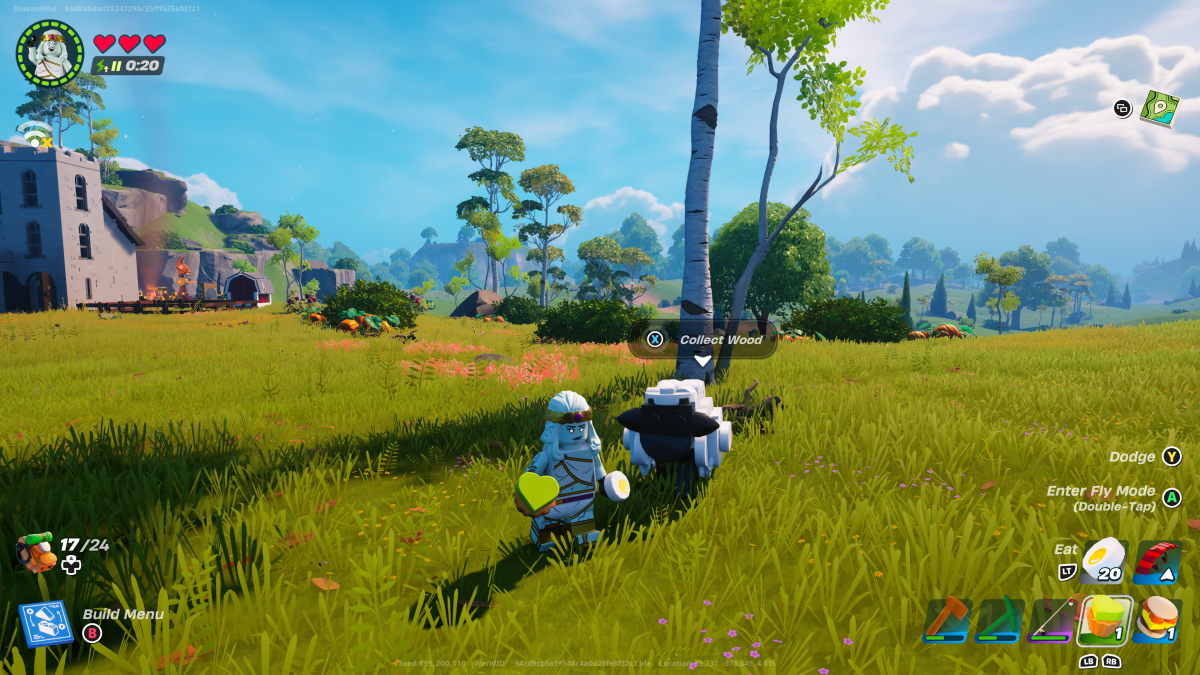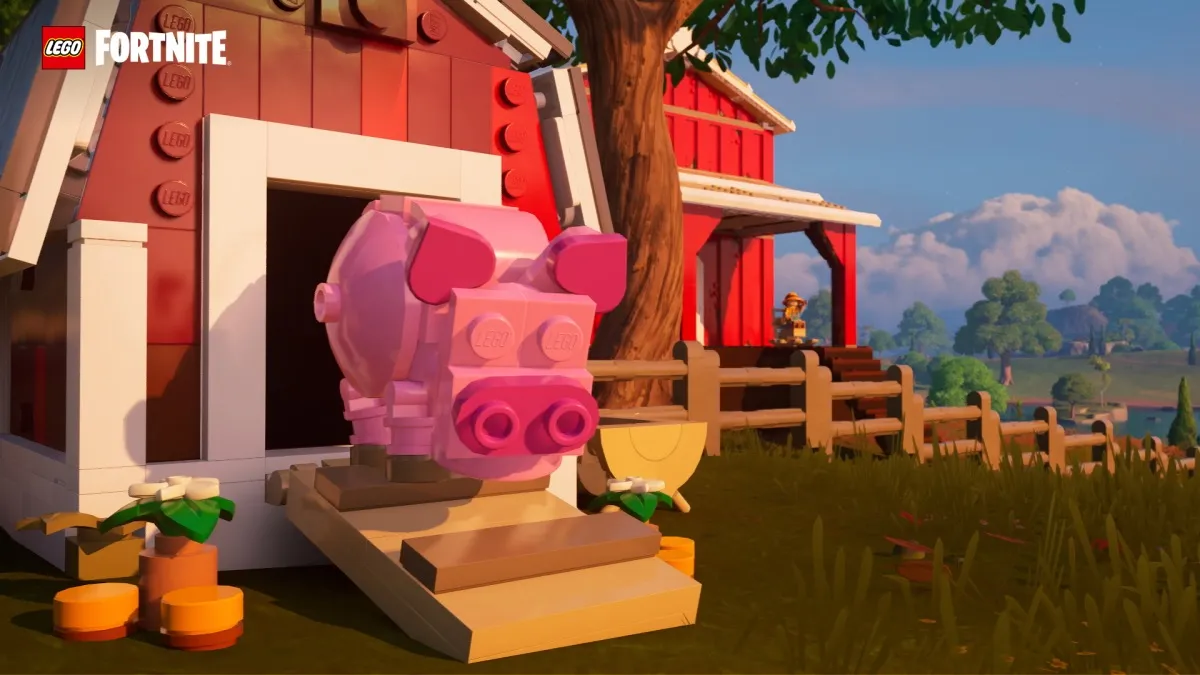Cyberpunk Review – PlayStation 4 (Played on PlayStation 5)
Editor’s Note: As stated above, Twinfinite played a PS4 copy of Cyberpunk 2077 on PS5 hardware. As a result, our experience is likely to have been markedly different from those attempting to play the game on PS4.
Other staff members have reported serious performance issues on previous console generation hardware that are still very problematic at the time of publishing. If you’re reading this you should consider this review a look into how Cyberpunk 2077 plays when played on hardware that is able to properly run it.
This review and the score the follows only considers the Cyberpunk 2077 experience playing on PS5. It is our recommendation that you avoid playing Cyberpunk 2077 on last-gen hardware entirely until updates are made to improve performance.
The memory of watching Cyberpunk 2077’s first gameplay presentation at E3 2018 is one I’ve thought of frequently over the past few weeks. Vertical slices so often promise a level of perfection rarely achieved in the final product, but what had intrigued me back then wasn’t so much what I had seen of Night City’s tremendous scale and density but the glue I hoped would hold it all together.
The reality, though, is that while Night City’s dystopian labyrinth of dingy streets and towering skyscrapers deliver a breathtaking spectacle, it too often feels as though it’s held together with string and tape.
Even when it’s firing on all cylinders, it never truly exists and reacts in the way I’d hoped as the next big open-world from CD Projekt Red, the master craftsmen behind The Witcher 3: Wild Hunt.
If you expected a truly next-generation open-world design, this sadly isn’t it. Night City is more of a carefully organized stage, rather than a living, breathing habitat — a grand facade best absorbed from the periphery, not to be examined too closely lest you accidentally see behind the curtain.
And yet, I’ve still been extremely impressed by much of what Cyberpunk 2077 has to offer. Putting the disastrous, even scandalous, situation surrounding its launch aside, there’s no doubt in my mind that judged as an overall experience, it’s a great RPG that thrills and delights far more than it frustrates.
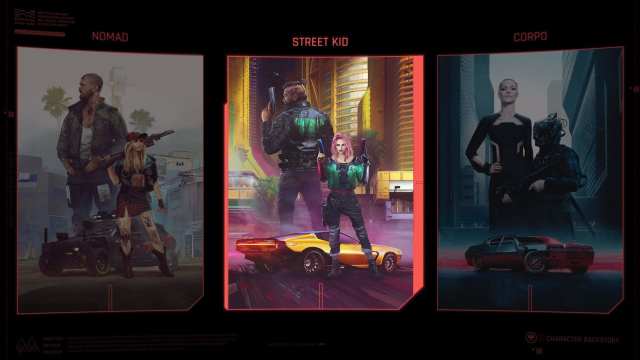
Cyberpunk 2077 begins as it ends, by placing a key decision in the hands of the player. There are three “life paths” to consider in choosing a backstory for its main protagonist, V. Each of these kickstarts Cyberpunk 2077’s story in a completely different location and, importantly, sets the tone for what sort of responses V is able to muster for the rest of the game.
As a “corpo,” for example, a unique set of dialog options allow V to chime in with insight into the shady, oppressive corporate world dominating Night City.
Raging against the machine, so to speak, is a central theme of the plot no matter which you choose, but I appreciated having control over V’s own motivations for bringing it down and the repercussions of my decision popping up throughout the rest of the story.
The main thrust of V’s plight is teed up over the course of a fairly lengthy prologue. At its climax, V is forced to insert a valuable “relic” chip into their mind to save it from destruction, but the chip holds more than binary data.
As it turns out, it’s actually a construct, a digitally preserved personality, of a terrorist named Johnny Silverhand (Keanu Reeves) who died half a century earlier. Now, V’s plight is not only to deliver the data to its benefactors but find a way to remove the chip from his mind without killing himself in the process.
Of course, Silverhand, now very much alive and lamenting life under the thumb of corporate overlords, has his own ideas. Slowly but surely, he and V’s disparate thoughts become ever more fused together, and his running commentary of events begin to influence V’s personality and decision-making.
The changing dynamic of this relationship forms a core pillar of the story and ends dramatically regardless of which of the game’s five different endings one experiences.
Surprisingly, it doesn’t take all that long to see it through, either, at just 25 or so hours.
Finishing the “side gigs,” however, doubles that number comfortably; and actually, not only do these optional adventures arguably feature more interesting stories but their characters also become intertwined in the main story if you want them to. In that sense, the overarching plot can sprawl in different directions beyond the scope of what’s necessary to “finish” the game.
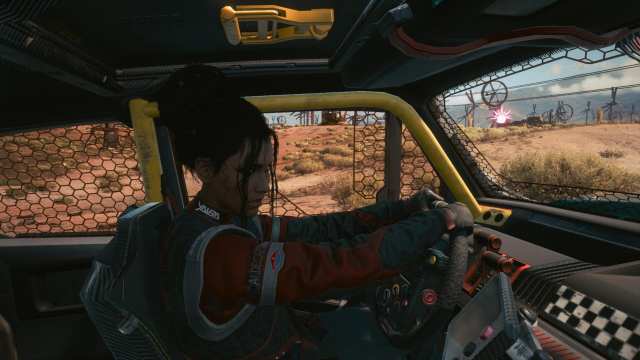
Further, the side characters you meet during these missions are brilliantly written and add the sort of emotional resonance one often needs to become truly immersed in a story.
Characters such as the vivacious Panam, for example, are introduced as part of the main questline, but there’s a lengthy and entirely optional side quest that further develops her character, offers a chance at romance, and even the option to involve her in the main story later down the track.
Rogue Amendiares, the hardline “Fixer,” and River Ward, the hardworking detective, are yet more examples of other terrific characters brought to life in huge, fascinating questlines that feel weighty and important in the context of the main story.
My only issue with Cyberpunk 2077’s narrative qualities is that for a game named after the genre itself, there’s too little examination of important themes like transhumanism and existentialism.
They’re alluded to, certainly, but only as a catalyst for the game’s aesthetic, and by skipping out on putting those themes under the microscope properly, Cyberpunk 2077 sometimes feels more like a pastiche of the genre without the substance.
There’s certainly no shortage of lingo to constantly remind you Cyberpunk 2077 is inspired by tropes of the genre, though. Between “cyberdecks,” “ICE,” “choombas,” “flatlining,” and “preem” fashion styles like Neokitch and Entropism, there’s an awful lot of jargon to absorb in quick order.
There’s an attitude to the dialog that screams 1980s punk; the abbreviated words, choppy sentences, and bizarre slang is a signature of the rebellious, angsty dystopian sci-fi popular during the era.
But it does feel a little dated at times, and there’s definitely an element of cheese to proceedings. I can’t help but wonder whether somebody who hasn’t read or watched cyberpunk fiction would appreciate it.
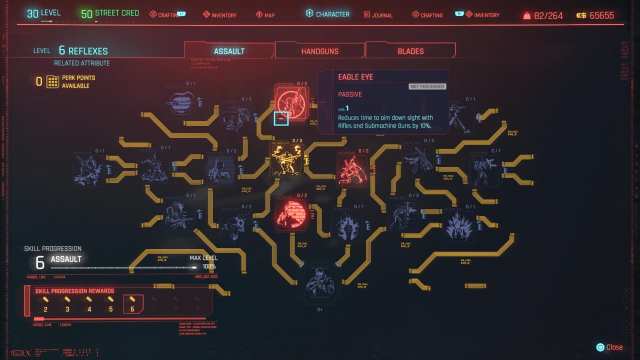
But I’m certain it doesn’t make the game’s opening hours easier because beyond the jargon there’s a lot of RPG mechanics to quickly wrap your head around. I find there’s always a “settling in” period in any game of this genre, but particularly so in Cyberpunk 2077.
The systems that govern character progression are fairly standard, but how everything correlates to weapons, armor, hacking abilities, cyberware augmentations, crafting, and all the various different upgrades requires serious concentration.
Particularly so, because the neon-colored menus and the layout of the UI, in general, is a little unorthodox and hard to make sense of until you’re up to speed.
There’s certainly a lot of playing around in Cyberpunk 2077’s menus to be done, too, which is exacerbated by the need to constantly switch gear in and out.
Right up until the late game, weapons and items feel as though they only have value for minutes before finding something else with better stats, which is a system I’ve experienced in other RPGs and never really cared for.
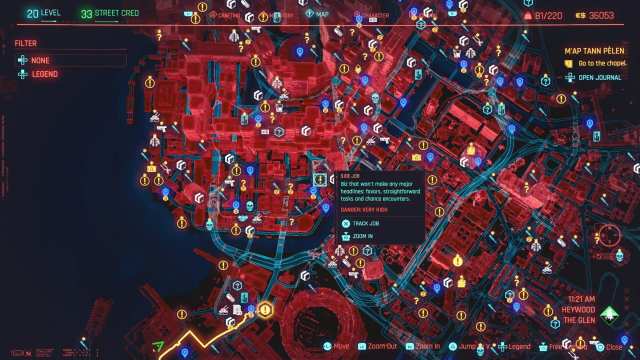
In the end, I found myself more or less settling on a trio of weapons and immediately breaking everything else down for crafting parts. And you are picking up a heck of a lot after every combat encounter, of which there are literally hundreds on offer spread across Night City.
From random question mark activities and combat encounters to slightly longer “gigs” issued by “Fixers” (middlemen), there are hours of fun to be had zooming across town and knocking off activities.
It’s more or less standard open-world stuff, but what makes that loop especially fun is Cyberpunk 2077’s surprisingly great shooting mechanics.
As a polar opposite to the sword-slashing, third-person action of The Witcher trilogy, gunplay is entirely new ground for CD Projekt Red, but you’d never have guessed that given how impressive shooting feels.
I think the development team deserves a huge amount of credit for nailing the type of slick gunplay you’d expect from a conventional shooter. It’s not Call of Duty levels of control and precision, but it’s a lot more tactile and satisfying to shoot weapons in Cyberpunk 2077 than I was expecting from an RPG. Certainly, it’s a step above, say, Fallout 4, which feels stiff and clumsy by comparison.
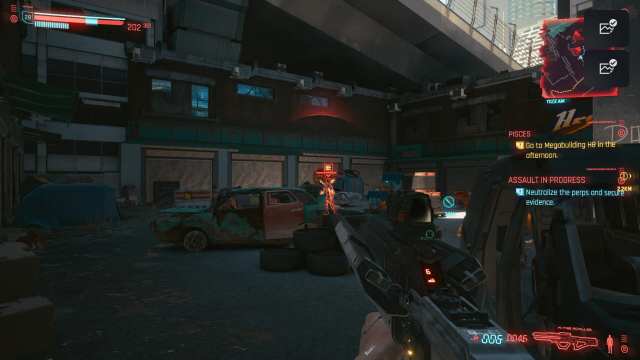
Melee combat is an option, too, but here I found myself comparing it to a Bethesda game for all the wrong reasons. Cyberpunk 2077 features Skyrim-like primitive attacking and blocking, with only the awesome designs of the katana swords and Mantis Blades ever encouraging me to bother slicing enemies instead of blasting them.
The aforementioned cyberware, though, does add meaningful layers to the combat experience. “Quickhacks” serve as an equivalent to spells in fantasy games, which are executed by scanning enemies and applying different active and passive effects, such as short-circuiting enemy augmentations or jamming their weapons.
You can choose to get even more involved by engaging with a hacking mini-game that applies area-wide debuffs. The same system also allows V to hack into access points and steal money, too.
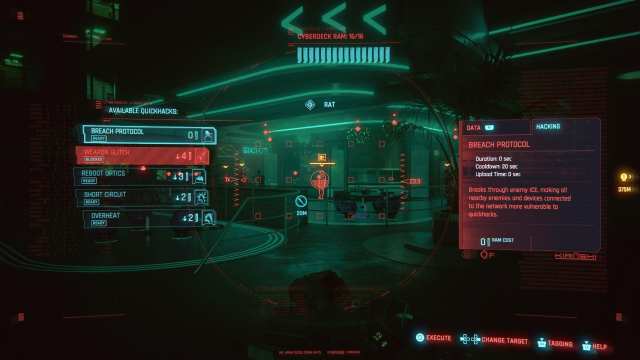
Unfortunately, Cyberpunk 2077’s surprisingly solid gunplay is let down by wonky AI, which is serviceable but ultimately disappointing. Enemy attack patterns, for example, are often one-dimensional and sometimes even comically predictable, meaning the challenge of a gunfight often boils down simply to having to deal with large numbers of combatants.
Occasionally, a netrunner hacking V’s cyberware gives you something to think about, and melee-wielding enemies force you to dodge and change strategy.
All too frequently, though, shootouts feel more like shooting galleries as you mow down dumb goons charging headfirst into your line of fire. It’s still fun and satisfying but doesn’t feel particularly cutting-edge for what is supposed to be an ambitious game.
In fact, disappointingly, the AI is rather poor across the board, with NPC pathing painfully uniform and constantly looping in circles –something that’s aggravated by Night City’s strange and underwhelmingly low population and traffic density.
The lack of AI sophistication also extends to police activity and Cyberpunk 2077’s “wanted” system, which mimics that found in Rockstar’s Grand Theft Auto games. Not only will police spawn out of absolutely nowhere, but they’re typically so easy to lose that committing a crime never really feels consequential.
Interestingly, in a recent conference call, CD Projekt Red spoke to the complaints about the game’s poor AI and its intention to deliver fixes moving forward.
Quite how that will improve the overall feel of Night City and combat encounters I’m not sure, but I do think it’s a telling acknowledgment on the part of the developer that Cyberpunk 2077 isn’t a finished game.
This all brings us to the elephant in the room — the bug-ridden, undercooked state in which the game was launched, and that so much has rightly been made of by both critics and players alike.
There’s just no getting away from the fact that Cyberpunk 2077 feels like an early access product still desperately in need of polish nearly two weeks after launch.
Already, two hotfix patches adding over 20 GB to the install size have made sizeable improvements to its stability since launch, but that doesn’t excuse the situation nor have they done much for the millions of players still enduring near-unplayable and unacceptable performance on previous generation consoles.

On PS5, my playthrough luckily wasn’t anywhere near as compromised, dogged initially by blurry textures that have since been fixed by the first hotfix patch (1.04), and one or two bugs and glitches that prevented progress and required me to reload a previous save.
Repeated crashes were the main issue, sometimes as frequently as two per hour. Although, with the most recent hotfix (1.05), they seemed to become less frequent, and in general, I’ve found the game’s stability much improved from when it initially launched. Had those two patches not arrived, I’m sure the gameplay experience would have been spoiled to such an extent that my overall impression considerably was less favorable.
In any case, Night City always feels fragile in a way that’s really quite uncharacteristic of CD Projekt Red, a team that earned a reputation not only for its ability to conceptualize a brilliant world but deliver the quality necessary to realize it. Cyberpunk 2077 needed much more time in the oven than it got, and it’s a real shame.
The result of that negligence is likely to have far-reaching consequences for CD Projekt Red’s reputation and legacy, which probably deserves an examination beyond the scope of this review.
But in terms of how it relates to the game itself, it means that instead of the instant classic it very well could have been, Cyberpunk 2077 falls short of the standard set by The Witcher 3: Wild Hunt.
It’s a very good RPG –great, even–, just not a seminal one that does anything to push open-world game design beyond what has been done before.
- A dense, dramatic open-world setting with a unique visual style.
- Surprisingly decent gunplay and driving physics.
- Often top-notch writing and quality storytelling.
- Replay value.
- A disappointing number of technical issues that are particularly prevalent on previous console generation hardware but still noticeable even on PS5.
- Night City is lacking in population, density, and isn't particularly interactive.
- Progression and crafting mechanics are deep but cluttered.
- The story doesn't adequately explore themes important to cyberpunk literature.

